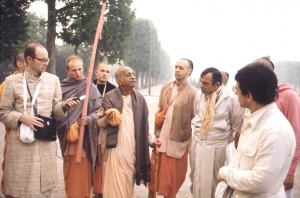SB 10.12.28: Difference between revisions
m (1 revision(s)) |
No edit summary |
||
| Line 1: | Line 1: | ||
{{info | {{info | ||
|speaker= | |speaker=Śukadeva Gosvāmī | ||
|listener=King | |listener=King Parīkṣit | ||
}} | }} | ||
[[Category:Srimad-Bhagavatam - Canto 10 Chapter 12]] | |||
[[Category:Bhagavatam Verses Spoken by Sukadeva Gosvami - Vanisource|101228]] | |||
<div style="float:left">'''[[Srimad-Bhagavatam]] - [[SB 10|Tenth Canto]] - [[SB 10.12: The Killing of the Demon Aghasura|Chapter 12: The Killing of the Demon Aghāsura]]'''</div> | |||
<div style="float:right">[[File:Go-previous.png|link=SB 10.12.27]] '''[[SB 10.12.27]] - [[SB 10.12.29]]''' [[File:Go-next.png|link=SB 10.12.29]]</div> | |||
{{RandomImage}} | |||
==== TEXT 28 ==== | ==== TEXT 28 ==== | ||
<div | <div class="verse"> | ||
kṛtyaṁ kim atrāsya khalasya jīvanaṁ | :kṛtyaṁ kim atrāsya khalasya jīvanaṁ | ||
na vā amīṣāṁ ca satāṁ vihiṁsanam | :na vā amīṣāṁ ca satāṁ vihiṁsanam | ||
dvayaṁ kathaṁ syād iti saṁvicintya | :dvayaṁ kathaṁ syād iti saṁvicintya | ||
jñātvāviśat tuṇḍam aśeṣa-dṛg ghariḥ | :jñātvāviśat tuṇḍam aśeṣa-dṛg ghariḥ | ||
</div> | </div> | ||
| Line 17: | Line 22: | ||
==== SYNONYMS ==== | ==== SYNONYMS ==== | ||
<div | <div class="synonyms"> | ||
kṛtyam | ''kṛtyam kim''—what to do; ''atra''—in this situation; ''asya khalasya''—of this envious demon; ''jīvanam''—the existence of life; ''na''—there should not be; ''vā''—either; ''amīṣām ca''—and of those who are innocent; ''satām''—of the devotees; ''vihiṁsanam''—the death; ''dvayam''—both actions (killing the demon and saving the boys); ''katham''—how; ''syāt''—can be possible; ''iti saṁvicintya''—very perfectly thinking about the subject matter; ''jñātvā''—and deciding what to do; ''aviśat''—entered; ''tuṇḍam''—within the mouth of the demon; ''aśeṣa-dṛk hariḥ''—Kṛṣṇa, who has unlimited potency, could understand past, future and present. | ||
</div> | </div> | ||
| Line 24: | Line 29: | ||
==== TRANSLATION ==== | ==== TRANSLATION ==== | ||
<div | <div class="translation"> | ||
Now, what was to be done? How could both the killing of this demon and the saving of the devotees be performed simultaneously? Kṛṣṇa, being unlimitedly potent, decided to wait for an intelligent means by which He could simultaneously save the boys and kill the demon. Then He entered the mouth of Aghāsura. | Now, what was to be done? How could both the killing of this demon and the saving of the devotees be performed simultaneously? Kṛṣṇa, being unlimitedly potent, decided to wait for an intelligent means by which He could simultaneously save the boys and kill the demon. Then He entered the mouth of Aghāsura. | ||
</div> | </div> | ||
| Line 31: | Line 36: | ||
==== PURPORT ==== | ==== PURPORT ==== | ||
<div | <div class="purport"> | ||
Kṛṣṇa is known as ananta-vīrya-sarvajña because everything is known to Him. Because He knows everything perfectly well, it was not difficult for Him to find a means by which He could save the boys and at the same time kill the demon. Thus He also decided to enter the demon's mouth. | Kṛṣṇa is known as ''ananta-vīrya-sarvajña'' because everything is known to Him. Because He knows everything perfectly well, it was not difficult for Him to find a means by which He could save the boys and at the same time kill the demon. Thus He also decided to enter the demon's mouth. | ||
</div> | </div> | ||
__NOTOC__ | |||
<div style="float:right; clear:both;">[[File:Go-previous.png|link=SB 10.12.27]] '''[[SB 10.12.27]] - [[SB 10.12.29]]''' [[File:Go-next.png|link=SB 10.12.29]]</div> | |||
__NOTOC__ | |||
__NOEDITSECTION__ | |||
Revision as of 08:17, 20 May 2021

A.C. Bhaktivedanta Swami Prabhupada
TEXT 28
- kṛtyaṁ kim atrāsya khalasya jīvanaṁ
- na vā amīṣāṁ ca satāṁ vihiṁsanam
- dvayaṁ kathaṁ syād iti saṁvicintya
- jñātvāviśat tuṇḍam aśeṣa-dṛg ghariḥ
SYNONYMS
kṛtyam kim—what to do; atra—in this situation; asya khalasya—of this envious demon; jīvanam—the existence of life; na—there should not be; vā—either; amīṣām ca—and of those who are innocent; satām—of the devotees; vihiṁsanam—the death; dvayam—both actions (killing the demon and saving the boys); katham—how; syāt—can be possible; iti saṁvicintya—very perfectly thinking about the subject matter; jñātvā—and deciding what to do; aviśat—entered; tuṇḍam—within the mouth of the demon; aśeṣa-dṛk hariḥ—Kṛṣṇa, who has unlimited potency, could understand past, future and present.
TRANSLATION
Now, what was to be done? How could both the killing of this demon and the saving of the devotees be performed simultaneously? Kṛṣṇa, being unlimitedly potent, decided to wait for an intelligent means by which He could simultaneously save the boys and kill the demon. Then He entered the mouth of Aghāsura.
PURPORT
Kṛṣṇa is known as ananta-vīrya-sarvajña because everything is known to Him. Because He knows everything perfectly well, it was not difficult for Him to find a means by which He could save the boys and at the same time kill the demon. Thus He also decided to enter the demon's mouth.